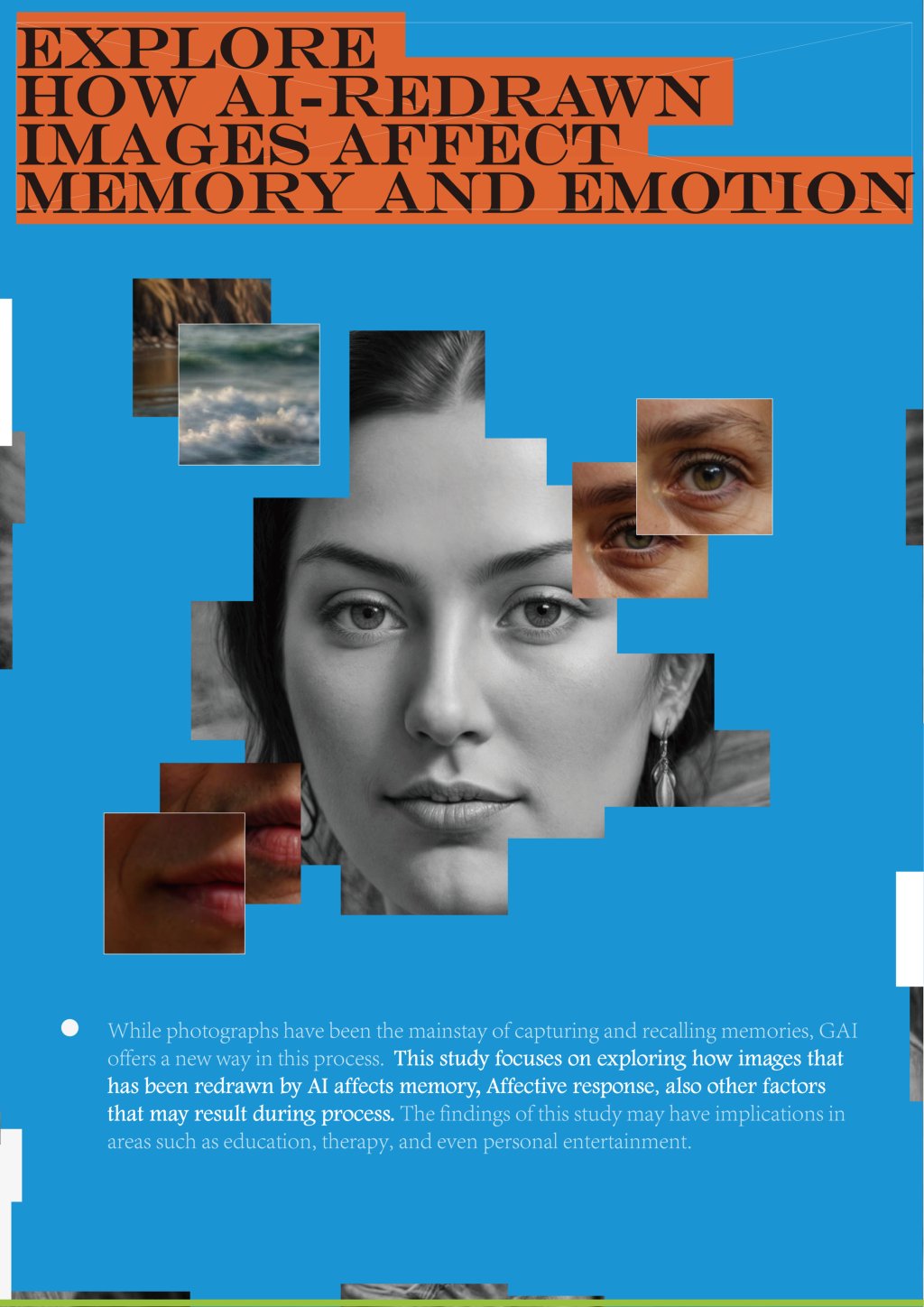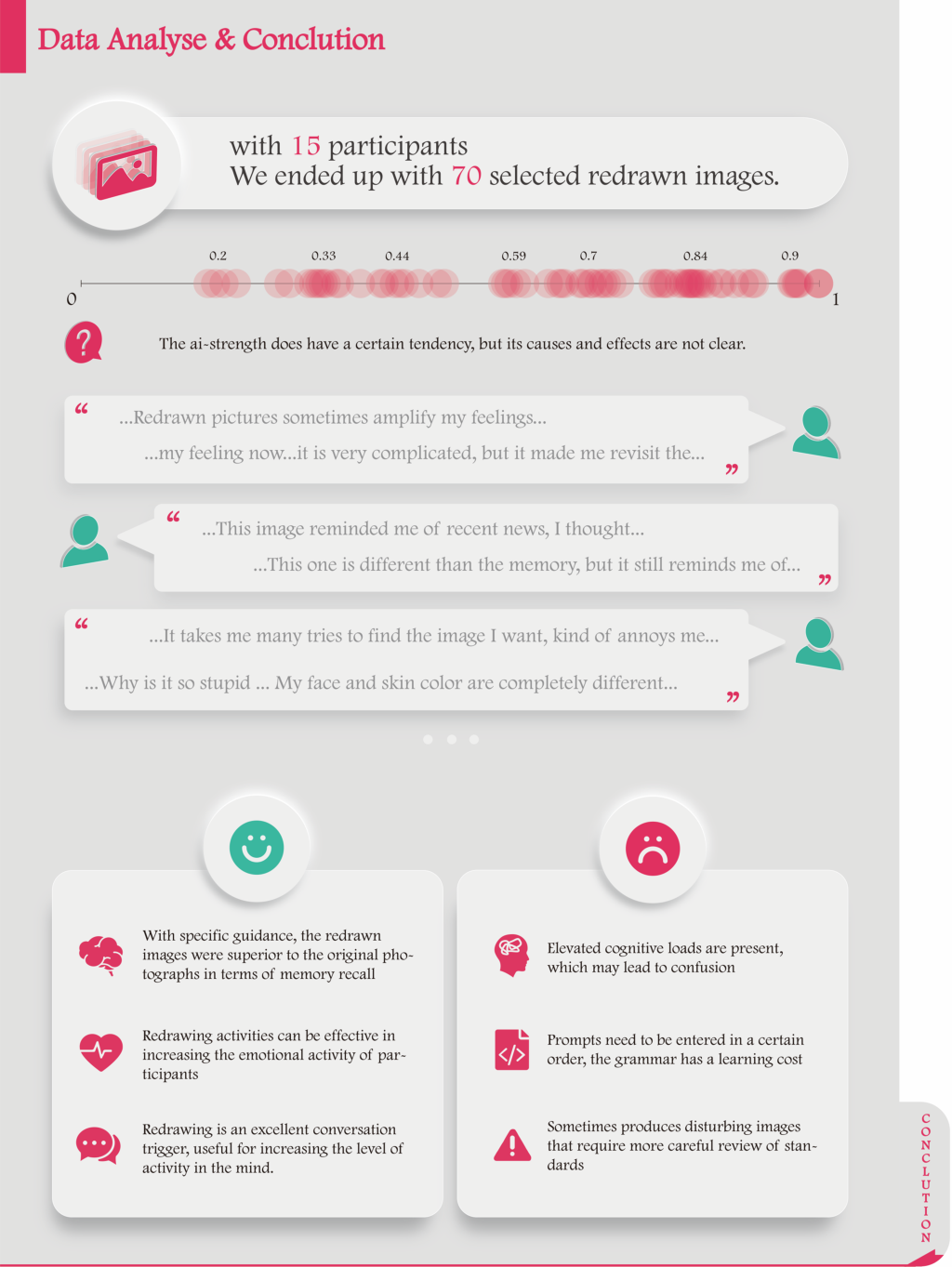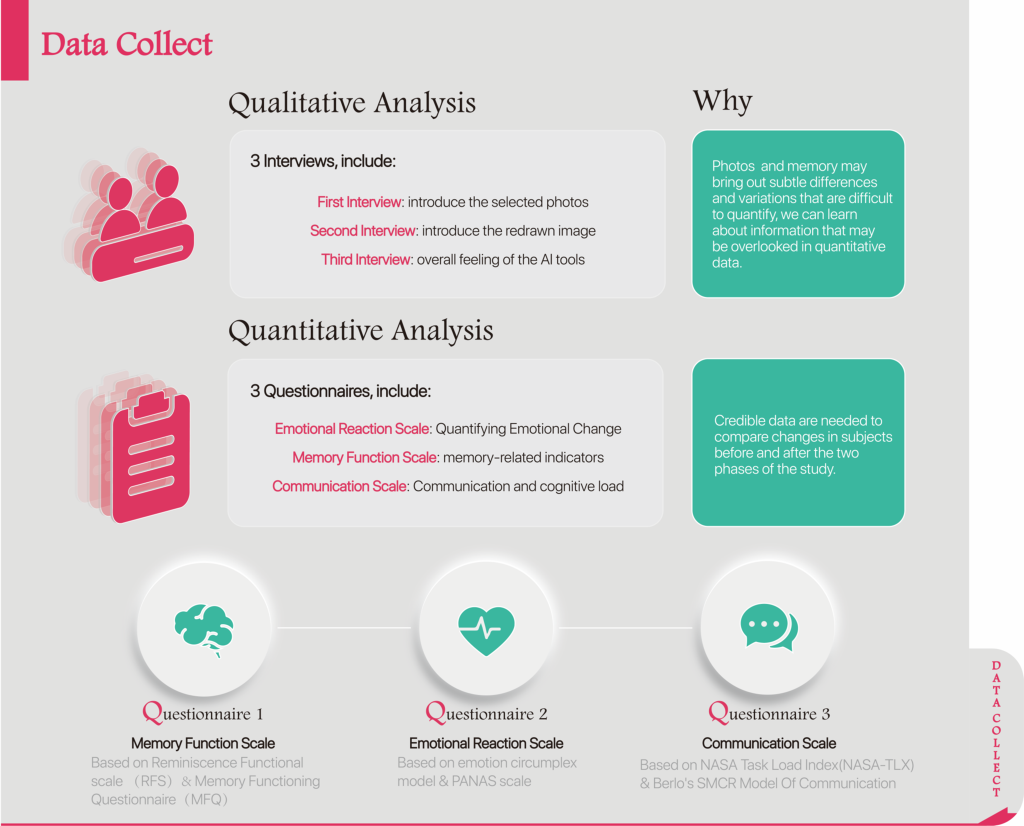A-EYE MEMORY: EXPLORE HOW AI-REDRAWN IMAGES AFFECT MEMORY, EMOTION AND COMMUNICATION
Zhou Fang
Photos are a powerful autobiographical memory trigger. People use them to capture and evoke memories. They not only help to recall past events, but also help to reconstruct and interpret them, so they play a vital role in shaping our personal identities and emotions. Previous studies have shown that photos, as memory cues, can evoke strong emotional responses and enhance the vividness of memory. These cues can link visual stimuli to information stored in the brain while an individual is viewing them, thus enhancing memory retrieval, so visual stimuli are often one of the anchors for personal narratives and personal identity formation . Existing recall therapies also commonly use photos as well as other personal belongings to enhance memory recall and emotional well-being, this approach has been shown to improve mood, cognitive function, and social interaction, especially in older adults and people with dementia Artificial intelligence tools, such as Generative Artificial Intelligence (GAI), can modify and enhance the visual stimulation of images. This technological intervention may give people new insights into how memories are constructed and altered.
For example, GAI can introduce elements that were not previously present in the original image, thereby creating new associations and altering the emotional impact of the memory. The controlled manipulation of photos by AI allows researchers to systematically explore how changes in visual stimuli can affect memory recall and other responses associated with it. This study focused on exploring how AI-redrawn photos affect memory recall in humans, and how emotions and communication related to memory change during this process. The primary research methodology involved recruiting participants from different cultural backgrounds, using semi-structured interviews and a series of questionnaires to record and quantify their reactions to the images before and after the redrawing using AI tools. There are two main contributions of this study. First, by integrating quantitative and qualitative data, it provides detailed support for subsequent relevant research. Second, the results are expected to provide valuable insights into the potential applications of AI in design and research in Cognitive Science.
How can GAI(Generative AI) affect memory through redraw photos?
Participants in this experiment were primarily recruited through social media platforms, such as posting recruitment messages in WhatsApp groups. In the end, a total of 15 participants took part in the test. Due to the potential influence of cultural backgrounds and age on the experimental results, participants were recruited from multiple countries, with the majority being adults aged between 18 and 30. Three participants were aged between 40 and 65. Before the experiment began, participants signed consent forms and were asked to provide a personal archival photograph. There were no specific requirements regarding the content or time period of the photographs, participants were only required to select images they found interesting and personally relevant.
The experiment was divided into two phases. In the first phase, participants were required to tell the researcher about their chosen photographs and recall details related to them. In the second stage, participants used KREA AI, a web-based AI drawing tool, to redraw the photos they chose. They could redraw the photos using their own memories of the photos to try to enrich the details, or redraw the photos according to their own preferences, or even redraw the photos by mixing other memories into the photos.

After a period of redrawing activity, participants were asked to select some photos they were interested in and conduct a second semi-structured interview based on them.
The redrawing of photographs not only involves the act of recalling, but during this process, the participants' emotions will undergo various kinds of emotional ups and downs according to the redrawn images, and this kind of recalling and emotional changes will also attract the participants to talk about their own feelings with others. The relationship between memory, emotion, and communication is complex and close, and a comprehensive study of these three aspects will help us to understand the effects of redrawing images on people in a more comprehensive way. To accomplish this, participants were asked to complete a set of questionnaires at the end of each phase of the experiment to record their mood changes, memory differences, and changes in communication after observing and talking about the images.
The results of the study show that the images redrawn using AI based on photos show certain potential in terms of memory arousal. In some cases, the comprehensive performance (in memory recall, emotion arousal, Improve communication) of the redrawn images is even better than the original images, and this advantage is more obvious when the participants use those photos that have little connection with themselves (Photos that they're not terribly familiar with). The "involvement of unexpected elements" is an interesting finding, and this uncertainty raises very interesting questions for future research: How can these unexpected elements become beneficial variables for research? Many of the participants expressed surprise at the presence of these elements, but overall they showed positive mood changes. At present, most research on AI and memory focus on how to use AI to generate questions and guide participants to recall through dialogues. In this experiment, AI redrawing images also showed a good ability to trigger dialogues. Compared with simply asking questions based on objects or preset contents, the dialogues triggered by redrawing images were more random and extensible. Based on this, future studies can integrate it into memory therapy. Another important finding is that redrawing images can change participants' emotions more intuitively, and images play an obvious role in emotional mobilization. This multi-modal emotional mobilization approach can provide more ideas for subsequent research. In addition, the process of AI redrawing itself is also interesting. From the perspective of interaction, this process similar to art creation is full of design space. Especially for special groups (such as the elderly), interaction is the key factor for its practical application. The experimental process also shows the problems that generative AI may bring, especially in the aspects of image ethics and potential emotional fluctuations. Uncontrollable factors add interest to redrawing, but also bring certain risks. In order to better control such risks, AI needs more training and the users need additional supervision mechanisms.

Most of the participants in this experiment were in their young and prime years and had good memory function,the time between the selected photos and the present was relatively short. Some participants said: "I have a good memory, it's not difficult for me to recall everything." This has had a certain impact on the results of the experiment, and further research in the future can invite more participants at different ages, and adjust the age distribution of participants according to the expected application field. Problems with the interaction of AI tools have affected the conduct of the experiment.

Improved AI interactions and even targeted training AI models can help improve the test, and more AI tools should be tested in the future. At the same time, this experiment only studied the impact of images on participants, and in the future, voice-related testing can be added on this basis to study how the mixing of multiple interaction methods will affect the experimental results.
This exploratory research involving fifteen participants, which focuses on exploring how AI redrawn images and redrawn process affects human memory, also the emotions and communication associated with memory. Through a series of quantitative and qualitative data collection, the final results reveal the potential of this technology in memory revoke, triggering dialogue, and enhancing emotional positivity, etc. At the same time, this research also reflects certain problems that currently exist in the interaction between ordinary people and AI, which can provide valuable references and guidance on how to apply this technology in the real world. The results of this study may provide new ideas for how to treat diseases such as Alzheimer's disease, amnesia, and senile depression.


Share
Contacts
- -



